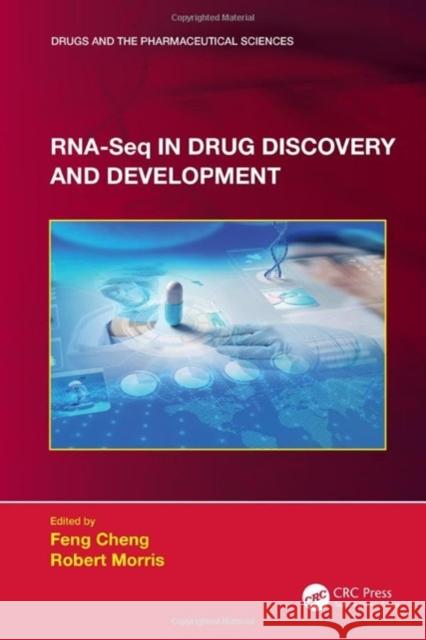RNA-Seq in Drug Discovery and Development » książka



RNA-Seq in Drug Discovery and Development
ISBN-13: 9781032004068 / Twarda / 2023 / 300 str.
RNA-Seq in Drug Discovery and Development
ISBN-13: 9781032004068 / Twarda / 2023 / 300 str.
(netto: 602,68 VAT: 5%)
Najniższa cena z 30 dni: 604,49
ok. 22 dni roboczych.
Darmowa dostawa!
This book addresses the various aspects of the RNA-seq technique, especially its application in drug discovery and development, including the identification of new drug targets, the prediction of drug activity or interactions, personalized medicine and toxicogenomics.
Chapter 1: Introduction to RNA-Sequencing and Quality Control
1.1: What is RNA-Sequencing?
1.2. Overview of RNA-sequencing
1.2.1. Isolation of the RNA and RNA quality check
1.2.2 Selection and depletion of particular RNA
1.2.3 Fragmentation
1.2.4 Reverse transcription to generate cDNA and adaptor sequences
1.2.5 Single-end and Pair-end Sequencing
1.3. RNA-seq Sequencing techniques:
1.3.1 Roche 454
1.3.2 Illumina platform
1.3.3 Small-scale RNA-seq platform
1.4. RNA-seq file format
1.4.1 Output file: Fastq file
1.4.2 Mapped file: SAM/BAM/BIGWIG formats
1.4.3 GTF file
1.4.4 BED File
1.5. Quality control of RNA-seq Data
1.5.1 Basic Usage of the Public Server Galaxy
1.5.2 FastQC program
1.6. Advantages of RNA-seq over microarrays
1.7. Summary
Chapter 2: Read Alignment and Transcriptome Assembly
2. Introduction
2.1 Transcriptome Assembly Methodology
2.1.1 De novo assembly
2.2 Genome-guided Assembly
2.2.1 Unspliced Aligners: Burrows-Wheeler Transform (BWT)
2.2.2 Unspliced Aligners: Seed Methods
2.3 Spliced Aligners
2.3.1 TopHat
2.3.2 HISAT2
2.3.3 STAR
2.4 Summary
Chapter 3: Normalization and Downstream Analyses
3.1 Introduction
3.2 Quantification of Transcript Abundance
3.3 Raw Counts Extraction
3.3.1 Rsubread and featurecounts
3.3.2 Normalization Methods
3.4 Differential gene expression analysis
3.4.1 DESeq2
3.4.2 EdgeR
3.4.3 Ballgown
3.5. Visualization of differential expression
3.5.1 Integrative Genomics Viewer (IGV)
3.5.2 UCSC Genome Browser
3.5.3 Heatmaps
3.5.4 Volcano Plots
3.5.5 DAVID Pathway Analysis
3.6. Summary
Chapter 4: Constitutive and Alternative Splicing Events
4.1. Introduction to RNA splicing
4.1.1 What is splicing?
4.1.2 Molecular mechanism of splicing
4.1.3 Alternative Splicing
4.2. Differential splicing analysis
4.2.1 Cuffdiff 2
4.2.2 DiffSplice
4.2.3 DEXSeq
4.2.4 edgeR
4.2.5 LIMMA
4.3. Summary
Chapter 5: The role of transcriptomics in identifying fusion genes and chimeric RNAs in cancer
5.1 Introduction to fusion genes
5.1.1 What is a fusion gene?
5.1.2 Mechanisms that generate new fusion genes
5.1.3 Fusion RNA transcripts
5.1.4 The connection between fusion genes and non-coding RNAs
5.2 Detection methods for identification of fusion genes and chimeric proteins
5.2.1 Guided detection approaches
5.2.2 High-throughput sequencing-based detection methods
5.3 Summary
Chapter 6: MiRNA and RNA-seq
6.1 Non-coding RNAs
6.2 MiRNAs
6.3 LncRNAs
6.4 miRDeep2
6.5 Applications
6.6 Summary
Chapter 7: Toxicogenomics and RNA-seq
7.1 Introduction of toxicity
7.1.1 Traditional toxicity study
7.2 Toxicogenomics
7.2.1 What is Toxicogenomics?
7.2.2 Advantages: Mechanisms and predictive toxicology
7.2.3 Mechanisms of toxicity:
7.2.4 Limitations of toxicogenomics:
7.3 Methods for toxicogenomics data analysis
7.3.1 Identification of Differentially expressed genes
7.3.2 Signature matching
7.3.3 Gene Networks
7.3.4 Co-expression networks
7.4 Toxicogenomics databases
7.4.1 Comparative Toxicogenomics Database (CTD)
7.4.2 Japanese Toxicogenomics Project (TGP)
7.4.3 DrugMatrix
7.5 Comparing microarray vs. RNA-seq
7.6 Summary
Chapter 8: Drug Discovery and Traditional Medicine
8.1 Introduction
8.2 What is herbal medicine?
8.2.1 Traditional medicine
8.2.2 Herbal medicine
8.2.3 Use of database for bioactive compound example
8.2.4 Properties of candidate herbal compounds
8.2.5 RNA-seq and herbal medicine
8.3 Mining functional genes of medicinal plants
8.3.1 Mining functional genes of medicinal plants
8.3.2 Discovery of secondary metabolites and their metabolic pathways
8.3.3 Discovery of developmental mechanisms
8.3.4 Development of molecular markers to improve plant breeding
8.3.5 Identification of target genes and molecular mechanisms of herbal drugs
8.3.6 Synergism of herbal compounds in pathway regulation
8.3.7 Herbal medicine toxicity
8.3.8 Natural drug repurposing
8.4 Summary
Chapter 9: Single-Cell RNA-sequencing
9. Introduction to single-cell sequencing
9.1 Microdroplet approaches to cell capture
9.2 Non-microfluidic approaches to cell capture
9.3 Single-cell processing: Cell Ranger
9.4 STARsolo
9.5 DropletUtils
9.6 Seurat
9.7 Limitations
9.8 Applications
9.9 Summary
Feng Cheng
Dr. Cheng is a computational biologist. He received systematic training in bioinformatics at Chinese Academy of Science, University of Illinois at Urbana Champaign, Rice University, University of Virginia and Yale University. His researches mainly focus on applications of bioinformatics methods for the identifications of drug-drug interactions (DDIs) and for drug repositioning by analyzing Big Data from public resources. He is also interested in computer-aided drug design. Dr. Cheng has published over 50 research papers in prestigious journals including Nature, Neuron, J. Am. Chem. Soc, and Scientific Reports. His work has been cited more than 1,600 times. Presently, Dr. Cheng is an editor board member of Journal of Proteomics and Bioinformatics, and the Open Bioinformatics Journal. Dr. Cheng has been serving as a peer reviewer for more than ten journals.
Robert Morris
Mr. Morris is a computational biologist with an M.S in molecular biology and is currently working on his MPH in applied biostatistics. His research primarily is focused on using bioinformatic tools to identify drug-drug interactions as well as identify risk factors associated with elevated risk of adverse drug reactions including bradycardia and dysphagia using publicly available Big Data. He also is focused on elucidating drug mechanisms using bioinformatics and RNA sequencing techniques. He currently has 10 publications in a variety of journals including the Journal of Alzheimer’s Disease and Brain Science. Finally, he has recently served as a peer reviewer for the Drugs – Real World Outcomes (DRWO) journal.
1997-2026 DolnySlask.com Agencja Internetowa
KrainaKsiazek.PL - Księgarnia Internetowa









